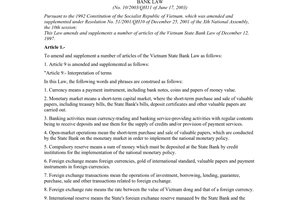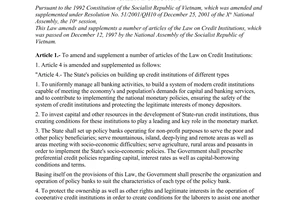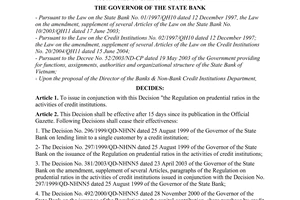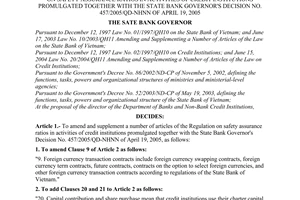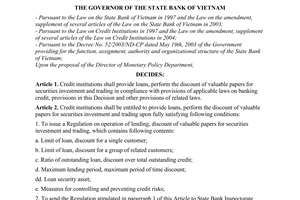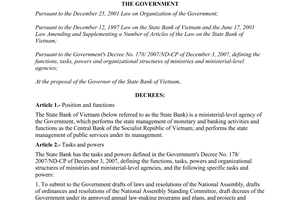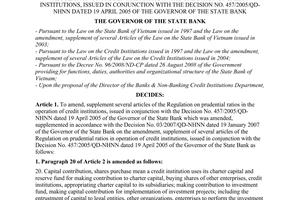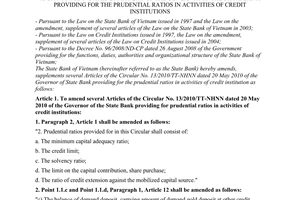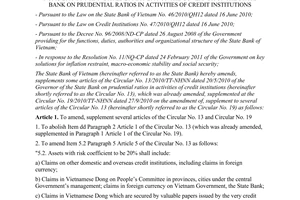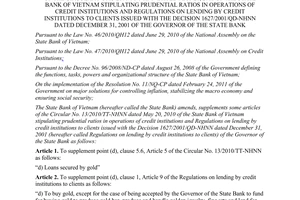Circular No. 13/2010/TT-NHNN stipulating prudential ratios in operations đã được thay thế bởi Circular No. 36/2014/TT-NHNN minimum safety limits ratios for credit institutions branches foreign banks và được áp dụng kể từ ngày 01/02/2015.
Nội dung toàn văn Circular No. 13/2010/TT-NHNN stipulating prudential ratios in operations
|
THE
STATE BANK OF VIETNAM |
SOCIALIST
REPUBLIC OF VIET NAM |
|
No. 13/2010/TT-NHNN |
Hanoi, May 20, 2010 |
CIRCULAR
STIPULATING PRUDENTIAL RATIOS IN OPERATIONS OF CREDIT INSTITUTIONS
Pursuant to the 1997 Law on
the State Bank of Vietnam and the 2003 Law Amending and Supplementing a Number
of Articles of the Law on the State Bank of Vietnam;
Pursuant to the 1997 Law on Credit Institutions and the 2004 Law Amending and
Supplementing a Number of Articles of the Law on Credit Institutions;
Pursuant to the Government's Decree No. 96/ 2008/ND-CP of August 26, 2008,
defining the functions, tasks, powers and organizational structure of the State
Bank of Vietnam;
The State Bank of Vietnam ( below referred to as the State Bank) stipulates
prudential ratios in operations of credit institutions as follows:
Chapter I
GENERAL PROVISIONS
Article 1. Subjects and scope of application
1. Credit institutions operating in Vietnam (below referred to as credit institutions for short), excluding the Social Policy Bank, the Vietnam Development Bank and grassroots people's credit funds, shall constantly maintain prudential ratios stipulated in this Circular in their operations.
2. Prudential ratios stipulated in this Circular include:
a/ Capital adequacy ratio;
b/ Credit limits;
c/ Solvency ratio;
d/ Limits on capital contribution and share purchase;
e/ Ratio of granted credit to mobilized capital.
3. On the basis of results of supervision, inspection and examination of credit institutions by the Banking Inspection and Supervision Agency, the Stale Bank may request credit institutions to maintain prudential ratios higher than the levels stipulated in this Circular.
Article 2. Interpretation of terms
In this Circular, the terms below arc construed as follows:
1. Receivables include assets formed from deposits, loans, advances, overdrafts, financial leasing amounts, factoring, discounts and re- discounts of negotiable instruments and other valuable papers, and securities investments.
2. Client means an organization or individual having credit relations with a credit institution. A single client is an organization or individual having credit relations with a credit institution.
3. Group of related clients consists of two or more clients having a credit relation with a credit institution, falling into one of the following cases:
a/ Parent company and its subsidiary company and vice versa: credit institution and its subsidiary company and vice versa; subsidiaries of the same parent company or credit institution; manager, member of the Control Board of parent company or credit institution, individual or organization competent to appoint such persons and subsidiary company, and vice versa:
b/ Company or credit institution and its manager or member of its Control Board or company or organization competent to appoint such person, and vice versa:
c/ Company or credit institution and individual or organization owning 5'% or more of charter capital or voting shares in the company or credit institution, and vice versa;
d/ Close relatives, including wife, husband, father, adoptive father, mother, adoptive mother, child, adopted child, blood sibling and wife or husband thereof;
e/ Company or credit institution and close relatives defined at Point d of this Clause of manager, member of Control Board, capital-contributing member or shareholder owning 5% or more of charter capital or voting shares of the company or credit institution, and vice versa:
f/ Individual authorized to be representative of an organization or individual defined at Point a. b. c. d or e of this Clause and authorizing organization or individual: individuals authorized to be representatives for contributed capital portions of the same organization:
g/ Group of individuals or organizations capable of controlling the decision making and operation of a company or credit institution through its Shareholders General Meeting or Members Council.
4. Subsidiary company of a credit institution means an enterprise or another credit institution that has the legal person status, practice independent accounting with own capital contributed or purchased as shares by the credit institution under regulations of the State Bank, which:
4.1 Possesses over 50% of charter capital or voting shares of the enterprise or other credit institution, except the case in which the ownership right is not associated with the right to control the enterprise or other credit institution; or
4.2 Possesses under 50% of charter capital or voting shares of the enterprise or other credit institution, but:
a/ Other shareholders or members agree to allow (he capital-contributing or share-purchasing credit institution to have over 50% of the voting right: or
b/ The credit institution has the right to control financial and operational policies under a regulation agreed between the credit institution and the enterprise or other credit institution: or
c/ The credit institution has the right to appoint or dismiss a majority of members of the Board of Directors or Members* Council or an equivalent management body of the enterprise or other credit institution; or
d/ The credit institution has the right to cast a majority vote at meetings of the Board of Directors or Member's Council or an equivalent body.
5. Affiliated company of a credit institution means a subsidiary of a credit institution operating in the fields of finance, insurance, banking and management, exploitation and sale of assets in the course of handling assets used as loan security and assets assigned by the State to the credit institution for debt recovery.
6. Joint-venture company of a credit institution means an enterprise or another credit institution that has the legal person status, practice independent accounting and is established from capital contributed on the basis of a joint-venture contract by the credit institution and other parties and jointly owned and controlled by the credit institution and these parties.
7. Associated company of a credit institution means an enterprise or another credit institution that has the legal person status and practice independent accounting and is established from capital contributed by the credit institution or has its shares purchased by the credit institution under regulations of the State Bank, and fully meets the following conditions:
a/ The credit institution has the right to participate in making decisions on financial and operational policies of the enterprise or other credit institution but does not control such policies;
b/ The credit institution owns between 20% and 50% of charter capital or voting shares of the enterprise or other credit institution:
c/ The associated company is not a subsidiary or joint-venture company of the credit institution.
8. Capital contribution, share purchase means the use by a credit institution of its charter capital and reserve fund for contribution to the charter capital or purchase of shares of enterprises, subsidiary companies, joint-venture companies, associated companies or other credit institutions; for allocation of charter capital to its affiliated companies; and for contribution to investment funds and executing investment projects: including entrustment of capital to other legal entities, organizations or enterprises for making investments in the above forms.
9. Real estate business means the use of capital for investing in, creating, purchasing, receiving the transfer of. leasing or hire-purchasing real estate for sale, transfer, lease, sub-lease or hire-purchase for profits.
10. Investments in the form of capital contribution and share purchase in order to acquire the right to control an enterprise include:
a/ Investments accounting for over 50% of charter capital or voting shares of another enterprise or credit institution;
b/ Investments accounting for a proportion lower than the level stipulated at Point a of this Clause but sufficient for controlling decisions of the Shareholders General Meeting or Members' Council.
11. Interest rate transaction contract means an interest rate swap contract, termed interest rate contract, interest rate option contract or another interest rate transaction contract stipulated by the State Bank.
12. Foreign currency transaction contract means a foreign currency swap contract, term foreign currency contract, futures contract, foreign currency option contract or another foreign contract transaction contract stipulated by the State Bank.
13. Retained earning means the portion of earning determined through audit by an independent audit organizations after payment of all taxes and appropriation for various funds under law and retained for addition to capital of a credit institution under law. Retained earnings of a joint-stock credit institution must be adopted by its Shareholders General Meeting.
14. Goodwill means the positive difference between the amount paid for the purchase of a financial asset and the book value of such asset by a credit institution arising from the merger of an enterprise of redemption nature conducted by the credit institution. Such financial assets must be fully reflected on the balance sheets of credit institutions.
15. OECD stands for the Organization for Economic Cooperation and Development.
International financial institutions include the International Bank for Reconstruction and Development (IBRD), the Inter-American Development Bank (IADB). the Asian Development Bank (ADB). the Africa Development Bank (AfDB). the European Investment Bank (EIB) and the European Bank for Reconstruction and Development (EBRD).
Article 3. Information technology
A credit institution must have a fully connected information technology system to:
1. Store, access and supplement a database on customers and market, assuring risk management under internal regulations of the credit institution.
2. Manage the cash flow, make statistics on and monitor capital and asset items, assuring the maintenance of prudential ratios in its operations stipulated by this Circular.
3. Implement the State Bank's regulations on reporting and statistics.
Chapter II
SPECIFIC PROVISIONS
Section I. CAPITAL ADEQUACY RATIO
Article 4. Capital adequacy ratio
1. Credit institutions, excluding foreign bank branches, shall maintain a capital adequacy ratio of 9% between their own capital and their total risk-weighted assets (individual capital adequacy ratio).
2. Credit institutions shall make consolidated financial statements under law. In addition to maintaining an individual capital adequacy ratio stipulated in Clause 1 of this Article, they shall concurrently maintain a capital adequacy ratio of 9% on the basis of consolidation of capital and assets of their own and their affiliated companies (consolidated capital adequacy ratio).
Article 5. Individual capital adequacy ratios of credit institutions
1. An individual capital adequacy ratio shall be determined as follows:
|
Individual capital adequacy ratio |
= |
Own capital |
|
Total risk-weighted assets |
In which:
- Own capital is the total of tier-1 capital stipulated in Clause 2 and tier-2 capital stipulated in Clause 3, minus deductibles stipulated in Clause 4 of this Article.
- Total risk-weighted assets are stipulated in Clause 5 of this Article.
2. Tier-1 capital includes is the aggregate of amounts specified in Clause 2.1 of this Article minus deductibles specified in Clause 2.2 of this Article.
2.1. Amounts constituting tier-1 capital include:
a/ Charter capital (already allocated capital, contributed capital):
b/ The charter capital supplementation reserve fund:
c/ The operation development investment fund;
d/ Retained earnings:
e/ Surplus shares permitted to be accounted as capital under law. minus the portion used for purchasing treasury stocks (if any).
2.2. Deductibles from tier-1 capital include:
a/ Goodwill;
b/ Business losses, including cumulated losses;
c/ Amounts contributed as capital to or used to purchase shares of other credit institutions;
d/Amounts contributed as capital to or used to purchase shares of subsidiary companies;
e/ Amounts contributed as capital to or used to purchase shares of an enterprise, an investment fund or an investment project exceeding 10% of the aggregate of amounts specified in Clause 2.1 of this Article after subtracting deductibles specified at Points a. b, c and d. Clause 2.2 of this Article:
f/ The aggregate of amounts contributed as capital and used to purchase shares after subtracting the amount in excess of the 10% limit stipulated at Point e. Clause 2.2 of this Article which is higher than 40% of the aggregate of amounts specified in Clause 2.1 of this Article after subtracting deductibles specified at Points a, b. c and d. Clause 2.2 of this Article: the amount in excess of this level shall be subtracted.
3. Tier-2 capital is the aggregate of amounts specified in Clause 3.1 of this Article within the limits stipulated in Clause 3.2 of this Article.
3.1. Amounts constituting tier-2 capital include:
a/ 50% of the credit balance of the account of fixed assets re-valuated under law;
b/ 40% of the credit balance of the account of financial assets re-valuated under law:
c/ The financial reserve fund:
d/ Convertible bonds issued by the credit institution meeting the following conditions:
(i) Having an original maturity of at least 5 years;
(ii) Not being secured with assets of the credit institution concerned:
(iii) The credit institution may not redeem them at their owners" request or on the secondary market or may redeem them only when it is so approved in writing by the State Bank on the condition that such redemption does not affect the prescribed prudential ratios;
(iv) The credit institution may stop paying interests thereon and carrying forward cumulated interests to the subsequent year if the interest payment will result in business losses in the year;
(v) In case the credit institution is liquidated, owners of convertible bonds may receive payments only after the credit institution has made payments to all other secured or unsecured creditors;
(vi) Interest rates, including those added to reference ones, may be increased only after 5 years from the date of issuance and only once throughout the period before conversion into common stocks.
e/ Other debt instruments fully meeting the following conditions:
(i) Being debts whose creditors may. in all circumstances, receive payments only after the credit institution has made payments to all other secured or unsecured creditors;
(ii) Having an original maturity of at least over 10 years;
(iii) Not being secured with assets of the credit institution concerned;
(iv) The credit institution may stop paying interests thereon and carry forward cumulated interests thereon to the subsequent year if the interest payment will result in business losses in the year;
(v) Creditors may be paid their debts immature by credit institutions only after it is so approved in writing by the .State Bank:
(vi) Interest rates, including those added to reference ones, may be increased only after 5 years as from the date of signing of contracts and only once throughout the term of loans.
3.2. Limits for determining tier-2 capital:
a/ The maximum total value of amounts stated at Points d and e. Clause 3.1 of this Article is equal to 50% of the value of tier-1 capital.
b/ The maximum financial reserve fund is equal to 1.25% of total risk-weighted assets stipulated in Clause 5 of this Article.
c/ During the last 5 years before becoming mature for conversion or payment, the value of amounts specified at Point d and e. Clause 3.1. of this Article must be annually deducted by 20% of their initial value.
d/ The maximum total value of tier-2 capital is equal to 100% of the value of tier-1 capital.
4. Deductibles from own capital:
4.1.100% of the debit balance of the account of fixed assets re-valuated under law;
4.2. 100% of the debit balance of the account of financial assets re-valuated under law.
5. Total risk-weighted assets are the total value of assets determined based on the extent of risk and the value of corresponding assets of off- balance-sheet commitments determined based on the extent of risk.
Assets determined based on the extend of risk shall be calculated by multiplying the value of assets by the corresponding risk co-efficient of assets stipulated in Clauses 5.1, 5.2. 5.3, 5.4. 5.5 and 5.6 of this Article.
Corresponding assets on off-balance-sheet commitments determined based on the extent of risk shall be calculated by multiplying the value of off-balance-sheet commitments and a conversion co-efficient stipulated in Clause 6.3 and a risk co-efficient stipulated in Clause 6.4 of this Article.
5.1. Assets with a 0% risk co-efficient include:
a/ Cash;
b/ Gold;
c/ Deposits at the Social Policy Bank under regulations on credit for the poor and other policy beneficiaries;
d/ Vietnam-dong receivables from or guaranteed by the Vietnamese Government or the State Bank;
e/ Discounts and re-discounts of valuable papers issued by the credit institution itself;
f/ Vietnam-dong receivables secured with valuable papers issued by the credit institution itself; receivables fully secured with cash, savings books, escrow deposits and valuable papers issued by the Government or the State Bank;
g/ Receivables from central governments or central banks of OECD member states;
h/ Receivables secured with securities of central governments of OECD member states or receivables the payment of which is guaranteed by central governments of OECD member states.
5.2. Assets with a 20% risk co-efficient include:
a/ Receivables from other credit institutions at home and abroad, including foreign-currency ones:
b/ Receivables from provincial-level People's Committees: foreign-currency receivables from the Vietnamese Government or the State Bank;
c/ Foreign-currency receivables secured with valuable papers issued by the credit institution itself. Receivables secured with valuable papers issued by other credit institutions established in Vietnam:
d/ Receivables from state financial institutions; receivables secured with valuable papers issued by state financial institutions;
e/ Precious metals (except gold), gems:
f/ Receivables from international financial institutions and receivables the payment of which is guaranteed by these institutions or which are secured with securities issued by these institutions;
g/ Receivables from banks established in OECD member states and receivables the payment of which is guaranteed by these banks:
h/ Receivables from securities companies established in OECD member states which comply with agreements on risk-based capital management and supervision and receivables of which the payment is guaranteed by these companies;
i/ Receivables from banks established in countries outside OECD which have a residual maturity of under one year and receivables with a residual maturity of under one year guaranteed by these banks.
5.3. Assets with a 50% risk co-efficient include:
a/ Investments in projects under contracts of financial companies under regulations on the organization and operation of financial companies:
b/ Receivables wholly secured with houses, land use rights or houses attached with land use rights of borrowers or with those assets which have been leased by borrowers but are allowed by their lessees to be used by lessors as mortgages during the lease term.
5.4. Assets with a 100% risk coefficient include:
a/ Contributed capital amounts or purchased shares, excluding those of subsidiary companies, joint-venture companies, associated companies and deductibles from tier-1 capital stipulated at Points c. d. e and f. Clause 2.2 of this Article:
b/ Receivables from banks established in countries outside OECD which have a residual maturity of one year or longer, and receivables with a residual maturity of one year or longer of which the payment is guaranteed by these banks:
c/ Receivables from central governments of countries outside OECD. excluding those in their national currencies and from sources also in their national currencies.
d/ Investments in machines, equipment, fixed assets and other real estate under law.
e/ Receivables other than those specified in Clauses 5.1, 5.2. 5.3. 5.4. 5.5 and 5.6 of this Article.
5.5. Assets with a 150% risk co-efficient include loans granted to subsidiary, joint-venture and associated companies of the credit institution, excluding receivables specified in Clause 5.6 of this Article.
5.6. Assets with a 250% risk co-efficient include:
a/ Loans granted for securities investment:
b/ Loans granted to securities companies;
c/ Loans granted for real estate business purposes.
6. Corresponding assets of off-balance-sheet commitments shall be calculated based on the extent of risk on the following principles and order:
6.1. Convert the value of off-balance-sheets commitments into the value of corresponding assets using a conversion coefficient specified in Clause 6.3 of this Article.
6.2. Multiply the value of corresponding assets of each off-balance-sheet commitment by a corresponding risk co-efficient specified in Clause 6.4 of this Article.
6.3. Conversion coefficients of off-balance-sheet commitments:
a/ Off-balance-sheet commitments with a 100% conversion coefficient include irrevocable commitments replacing the direct grant of credit but having an extent of risk equal to the direct grant of credit, including:
(i) Loan guarantee;
(ii) Payment guarantee;
(iii) Amounts certified by letter of credit: letters of credit to provide financial guarantee for granted loans and issued securities; amounts with accepted payment, including amounts with accepted payment in the form of endorsement, except amounts of which payment in drafts has been accepted under Point c (ii). Clause 6.3 of this Article.
b/ Off-balance-sheet commitments with a 50% conversion co-efficient include irrevocable commitments with regard to the responsibility of the credit institution to make payment on behalf of debtors, including:
(i) Contract performance guarantee;
(ii) Bidding guarantee:
(iii) Other guarantees;
(iv) Standby letters of credit other than letters of credit specified at Point a (iii). Clause 6.3 of this Article:
(v) Other commitments with an original maturity of one year or longer.
c/ Off-balance-sheet commitments with a 20% conversion coefficient include commercial commitments, including:
(i) Irrevocable letters of credit:
(ii) Acceptances of payment of short-term bills of exchange secured with merchandise:
(iii) Merchandise delivery guarantee;
(iv) Other related commercial commitments.
d/ Off-balance-sheet commitments with a 0% conversion coefficient include:
(i) Revocable letters of credit; (ii) Other unconditional revocable letters of credit;
e/ Conversion coefficients of interest rate transaction contracts:
(i) Having an original term of under 1 year: 0.5%
(ii) Having an original term of between 1 year and under 2 years: 1 %
(iii) Having an original term of 2 years or longer: 1% for the duration of under 2 years plus (+) 1% for each additional year.
f/ Conversion co-efficients of foreign-currency transaction contracts:
(i) Having an original term of under 1 year: 2 %
(ii) Having an original term of between 1 year and under 2 years: 5 %
(iii) Having an original term of 2 years or longer: 5% for the duration of under 2 years plus (+) 3 % for each additional year.
6.4. Risk coefficients of the value of assets corresponding to each off-balance-sheet commitment are as follows:
a/ Off-balance-sheet commitments the payment of which is guaranteed by the Vietnamese Government or Stale Bank or wholly guaranteed with cash, saving books, escrow deposits or valuable papers issued by the Vietnamese Government or State Bank: 0%;
b/ Off-balance-sheet commitments secured with real estate: 50%;
c/ Interest-rate transaction contracts, foreign-currency transaction contracts and other off-balance-sheet commitments: 100%.
Article 6. Consolidated capital adequacy ratios
1. Credit institution shall make consolidated financial statements under law based on balance sheets, financial statements, consolidated financial statements and other information to maintain their consolidated capital adequacy ratios, as follows:
Subjects of consolidation are companies stated in the Regime of financial statements applicable to credit institution issued together with the State Bank Governor's Decision No. 16/ 2007/QD-NHNN of April 18. 2007. excluding insurance companies.
A consolidated capital adequacy ratio shall be determined as follows:
|
Consolidated capital adequacy ratio |
= |
Consolidated own capital |
|
Consolidated total risk-weighted assets |
In which:
- Own capital shall be determined to be the total of tier-1 capital stipulated in Clause 2 and tier-2 capital stipulated in Clause 3 of this Article, minus deductibles specified in Clause 4 of this Article.
- Total risk-weighted assets shall be determined under Clause 5 of this Article.
2. Tier-1 capital is the aggregate of amounts specified in Clause 2.1 of this Article minus deductibles specified in Clause 2.2 of this Article.
2.1. Amounts constituting tier-1 capital include:
a/ Amounts specified in Clause 2.1. Article 5 of this Circular;
b/ Exchange rate differences arising in the course of consolidating financial statements.
2.2. Deductibles from tier-1 capital include:
a/ Amounts specified at Points a and b. Clause 2.2. Article 5 of this Circular;
b/ Amounts contributed as capital to and purchased shares of other credit institutions;
c/ Amounts contributed as capital to and purchased shares of subsidiary companies not subject to consolidation of financial statements under law:
d/ Portion of amounts contributed as capital to and used to purchase shares of an enterprise, an investment fund or an investment project exceeding 10% of the aggregate of amounts specified in Clause 2.1 of this Article, after subtracting deductibles specified at Points a and b. Clause 2.2 of this Article;
e/ The aggregate of amounts contributed as capital to or used to purchase shares after subtracting the portion exceeding the 10% level specified at Point d. Clause 2.2 of this Article, which exceeds 40% of the aggregate of amounts specified in Clause 2.1 of this Article after subtracting deductibles specified at Points a and b. Clause 2.2 of this Article; the amount in excess of this level shall be subtracted.
3. Tier-2 capital is the total of amounts specified in Clause 3.1. of this Article subject to the limits specified in Clause 3.2 of this Article.
3.1. Amounts constituting tier-2 capital include:
a/ Amounts specified at Points a. b. c, d and e. Clause 3.1. Article 5 of this Circular:
b/ Benefits of minority shareholders.
3.2. Limits for determining ticr-2 capital:
a/ The total value of amounts specified at Points d and e. Clause 3.1.. Article 5 of this Circular is equal to 50% at most of the value of tier-1 capital.
b/ The total financial reserve fund is equal to 1.25% at most of total risk-weighted assets specified in Clause 5 of this Article.
c/ During the last 5 years before the conversion or payment becomes due. the value of amounts specified at Points d and e. Clause 3.1.Article 5 of this Circular shall be annually deducted by 20% of the initial value.
d/ The total value of tier-2 capital is 100% at most of the value of tier-1 capital.
4. Deductibles upon calculation of own capital: Amounts specified in Clauses 4.1 and 4.2. Article 5 of this Circular.
5. Total risk-weighted assets is the total value of assets minus amounts specified at Points b, c, d and e. Clause 2.2 of this Article and determined based on the extent of risk and the value of corresponding assets of off-balance-sheet commitments determined based on the extent of risk.
Assets determined based on the extent of risk shall be calculated by multiplying the value of assets by the corresponding risk coefficient of assets specified in Clauses 5.1. 5.2. 5.3. 5.4 and 5.5 of this Article.
Corresponding assets of off-balance-sheet commitments determined based on the extent of risk shall be calculated by multiplying the value of off-balance-sheet commitments by a conversion coefficient specified in Clause 6.3 and a risk coefficient specified in Clause 6.4. Article 5 of this Circular.
5.1. Assets with a 0% risk coefficient include amounts specified in Clause 5.1. Article 5 of this Circular.
5.2. Assets with a 20% risk coefficient include amounts specified in Clause 5.2, Article 5 of this Circular.
5.3 Assets with a 50% risk coefficient include amounts specified in Clause 5.3. Article 5 of this Circular.
5.4 Assets with a 100% risk coefficient include:
a/ Amounts specified at Points a and d. Clause 5.4, Article 5 of this Circular;
b/ Receivables specified at Points b and c. Clause 5.4. Article 5 of this Circular;
c/ Receivables other than those specified in Clauses 5.1. 5.2. 5.3, 5.4 and 5.5 of this Article.
5.5. Assets with a 250% risk coefficient include amounts specified in Clause 5.6. Article 5 of this Circular.
6. Corresponding assets of off-balance-sheet commitments shall be calculated based on the extent of risk on the following principle and order:
6.1 Converting the value of off-balance-sheet commitments into the value of corresponding assets using a conversion coefficient specified in Clause 6.3. Article 5 of this Circular.
6.2 Multiplying the value of corresponding assets of each off-balance-sheet commitment by the corresponding risk coefficient specified in Clause 6.4. Article 5 of this Circular.
Section 2. CREDIT LIMITS
Article 7. Identification of a single client and a group of related clients
1. In pursuance to this Circular and their internal regulations on credit quality management, credit institutions shall formulate and promulgate regulations on criteria for determining a single client and groups of related clients, credit policies applicable to clients and credit limits applicable to a single client and groups of related clients, which must contain at least the following contents:
a/ Specific criteria for determining a single client and a group of related clients.
b/ Credit limits applicable to a single client and a group of related clients.
c/ Plan for diversifying credit activities, methods of monitoring and managing credits worth 5% or more of own capital of the credit institution. Each lent, guaranteed or financial-leased amount and the total of lent amounts or the total of guaranteed amounts and the total of financial-leased amounts in excess of 10% of own capital of the credit institution is subject to approval of its Board of Directors or Chairman of the Board of Directors or a person authorized by the former according to the delegation and authorization of powers provided in the internal credit policy of the credit institution towards its clients.
2. Internal regulations on criteria for identifying a single client and a group of related clients, credit limits applicable to a single client and a group of related clients must be amended and supplemented in accordance with amendments and supplements to internal regulations on management of credit quality and credit policies towards clients when the internal credit rating system is annually revised.
3. Within 15 days from the date of issuing or revising internal regulations on criteria for identifying a single client and a group of related clients and credit limits applicable to a single client and a group of related clients, a credit institution shall send them to the -State Bank (the Banking Inspection and Supervision Agency) for reporting.
Article 8. Limits on loans, guarantees and discounts of valuable papers
1. The outstanding debts of a credit institution include outstanding debts under credit contracts, outstanding debts of loans lent by another credit institution under the entrustment of the credit institution and outstanding debts of amounts paid by the credit institution to perform its guaranty obligation for its clients.
The total outstanding debts of a credit institution for a single client must not exceed 15% of its own capital.
2. The total outstanding debts and guarantee amounts of a credit institution for a single client must not exceed 25% of its own capital, in which the total outstanding debts for a single client must not exceed the percentage specified in Clause 1 of this Article.
3. The total outstanding debts of a credit institution for a group of related clients must not exceed 50% of its own capital, in which the total outstanding debts for a single client must not exceed the percentage specified in Clause 1 of this Article.
4. The total outstanding debts and outstanding guarantee amounts of a credit institution for a group of related clients must not exceed 60% of its own capital, in which the total outstanding debts and outstanding guarantee amounts for a single client must not exceed the percentage specified in Clause 2 of this Article.
5. The total outstanding debts of a foreign bank branch for a single client must not exceed 15% of own capital of the foreign bank.
The total outstanding debts and guarantee amounts of a foreign bank branch for a single client must not exceed 25% of own capital of the foreign bank.
The total outstanding debts of a foreign bank branch for a group of related clients must not exceed 50% of own capital of the foreign bank, in which the total outstanding debts for a single client must not exceed 15% of own capital of the foreign bank
The total outstanding debt and guarantee amounts of a foreign bank branch for a group of related clients must not exceed 60% of own capital of the foreign bank.
6. A credit institution may not grant unsecured credits and credits under preferential conditions to enterprises which the credit institution holds the right to control, and shall comply with the following restrictions:
a/ The total outstanding debts and guarantee amounts of a credit institution for an enterprise which the credit institution has the right lo control must not exceed 10%' of own capital of the credit institution.
b/ The total outstanding debts and guarantee amounts of a credit institution for more than one enterprise which the credit institution has the right to control must not exceed 20% of own capital of the credit institution;
c/ A credit institution may grant unsecured credit to its affiliated financial leasing companies equal to 5% at most of its own capital provided that it ensures the limits specified at Points a and b of this Clause.
7. A credit institution may not grant credit to its affiliated companies being securities trading businesses.
8. A credit institution may not provide unsecured loans for securities investment and trading.
9. The total outstanding debts and discounts of valuable papers for all clients for securities investment and trading must not exceed 20% of the credit institution.
10. In case the capital need of a single client exceeds the loan limits specified in Clauses 1. 2. 3. 4 and 5 of this Article, credit institutions and foreign bank branches may provide syndicated credit under regulations of the State Bank.
11. In special cases, in order to perform socio economic tasks, if capital syndication abilities of credit institutions and foreign bank branches fail to meet loan or financial lease requirements of a single client, the Prime Minister may decide on specific loan or financial lease levels on a case-by-case basis.
Article 9. Limits on financial leasing
1. The total outstanding financial leasing debts for a single client must not exceed 30% of own capital of the financial leasing company.
2. The total outstanding financial leasing debts for a group of related clients must not exceed 50% of own capital of the financial leasing company, in which the financial leasing amount for a single client must not exceed the ratio stipulated in Clause 1 of this Article 1.
Article 10. Cases of non-application
The limits specified in Articles 8 and 9 of this Circular do not apply to loans and guarantee amounts in the following cases:
1. Loans sourced from capital entrusted by the Government, organizations and individuals or in case borrowers are other credit institutions; loans granted to the Vietnamese Government.
2. Loans and guarantees with a maturity of under I year granted to other credit institutions operating in Vietnam.
3. Loans and guaranteed wholly secured with Vietnamese Government bonds or bonds issued by governments of OECD member states.
4. Loans and guarantees fully secured with deposits, including savings and escrow deposits, at the credit institution.
5. Loans and guarantees fully secured with valuable papers issued by the credit institution itself.
6. Loans and financial leasing amounts with specific levels decided by the Prime Minister for a single client.
7. Loans and guarantees approved in writing by the State Bank.
8. Financial leasing amounts sourced from capital entrusted by the Government or organizations or to lessees being other credit institutions to which the financial leasing company is affiliated.
Section 3. SOLVENCY RATIOS
Article 11. Management of solvency
1. Credit institutions shall set up a unit (at the sectional or higher level) to manage liabilities and assets for monitoring and managing their day-to-day solvency. This unit shall be placed under the charge of the Director General (Director) or an authorized Deputy Director General (Deputy Director).
2. Credit institutions shall formulate and issue internal regulations on solvency management with regard to Vietnam dong. euro. British pound
and US dollar (including the US dollar and other foreign currencies converted into the US dollar at the interbank exchange rate at the end of each day) which must contain at least the following contents:
2.1. Authorization, decentralization, functions, tasks and powers of related units and individuals in the management of liabilities and assets and the assurance of solvency ratios.
2.2. Processes of making statistics, formulation, management and monitoring of maturities of liabilities and assets . System of measurement, assessment and reporting on solvency and liquidity and system of early warning on temporary solvency inadequacies and solutions.
2.3. Solutions to ensure solvency and liquidity in case of temporary solvency inadequacies or liquidity crises.
2.4. Plans and measures to increase the holding of valuable papers of high liquidity.
2.5. Formulation of a model for assessing and experimenting solvency and liquidity (stress- testing model). This model must have scenarios for solvency and liquidity analyses, which must ensure:
a/Analysis of minimum scenarios including the following two cases:
- Cash flow from business operations of the credit institution is normal;
- Cash flow from business operations of the credit institution has solvency and liquidity difficulties.
b/ Analysis of scenarios must reflect the following details:
- Ability to fulfill day-to-day obligations and commitments:
- Solutions to be taken so that the credit institution has solvency for at least seven (7) days in case it has solvency and liquidity difficulties.
3. Internal regulations on solvency management must be adopted by the Board of Directors and be reviewed, amended and/or supplemented at least once every six months or upon request of the State Bank (the Banking Inspection and Supervision Agency).
For foreign bank branches, their internal regulations on solvency and liquidity management must be approved by their foreign banks.
4. Credit institutions shall report to the State Bank (the Banking Inspection and Supervision Agency) on:
4.1. Their internal regulations on solvency management and amendments and supplements thereto within 5 days after promulgation or amendment and supplement.
4.2 Solvency or liquidity risks and solutions thereto immediately after they arise.
Article 12. Solvency ratios
At the end of each day. a credit institution shall determine and take measures for ensuring its solvency ratios for the subsequent day as follows:
1. The minimum ratio of 15% between total assets payable on demand and total liabilities.
1.1. Total assets payable on demand:
a/ Cash balance, book value of gold in the fund:
b/ Cash balance and book value of gold deposited at the State Bank (excluding compulsory reserve deposits);
c/ Positive difference between the balance of demand cash deposits and the book value of demand gold deposits at other credit institutions excluding the Social Policy Bank and the balance of demand cash deposits and the book value of demand gold deposits of other credit institutions at the credit institution concerned;
d/ Positive difference between the balance of time cash deposits and the book value of time gold deposits which will become mature at other credit institutions, excluding the Social Policy Bank and the balance of time cash deposits and the book value of time gold deposits which will become due of other credit institutions at the credit institution concerned;
e/ The book value of bonds or public bonds issued or the payment of which is guaranteed by the Vietnamese Government, governments or central banks of OECD member states;
f/ The book value of treasury bills and bills issued by the State Bank;
g/ The book value of bonds issued by local administrations, local financial investment companies and the Vietnam Development Bank;
h/ The book value of securities listed on Vietnam-based stock exchanges which must not exceed 5% of payable debts;
i/ The book value of other securities and valuable papers accepted by the State Bank for rediscount or depositing and transaction in monetary market operations.
1.2. Total payable debts shall be determined based on the balance on the total payable debts item.
2. The minimum ratio of I between total assets which will become due in 7 subsequent days counting from the following day and total liabilities which will become due in 7 subsequent days counting from the following day for Vietnam dong. euro. British pound and US dollar (including the US dollar and other remaining foreign currencies converted into the US dollar at the interbank exchange rate at the end of each day).
2.1. Assets which will become due in 7 subsequent days counting from the following day include:
a/ The cash balance of the fund at the end of the previous day;
b/ The book value of gold at the end of the previous day. including gold deposited at the State Bank and other credit institutions;
c/ The balance of deposits at the State Bank (excluding compulsory reserve deposits) and demand deposits at other credit institutions at the end of the previous day;
d/The balance of time deposits at other credit institutions which will become due in 7 subsequent days from the following day.
e/ 95% of securities issued or the payment of which is guaranteed and held by the Vietnamese Government and governments of OECD member states at the end of the previous day;
f/ 90% of the value of securities issued or the payment of which is guaranteed and held by credit institutions operating in Vietnam or by banks of OCED member states at the end of the previous day:
g/ 85% of the value of other securities listed and held at the end of the previous day;
h/ 80% of outstanding secured loans and financial leasing amounts, excluding non-performing loans, which will become due in 7 subsequent days counting from the following day;
i/ 75% of outstanding unsecured loans, excluding non-performing loans, which will become due in 7 subsequent days counting from the following day.
2.2. Liabilities which will become due in 7 subsequent days counting from the following day:
a/ The balance of demand deposits of other credit institutions at the end of the previous day;
b/The balance of time deposits of other credit institutions, organizations and individuals which will become due in 7 subsequent days counting from the following day;
c/ 15% of the average balance of demand deposits of organizations (excluding deposits of other credit institutions) and individuals during 30 preceding days counting from the previous day. The credit institution shall determine this average balance as a basis for calculation;
d/ Outstanding loans borrowed from the Government and the State Bank which will become due in 7 subsequent days counting from the following day;
e/ Outstanding loans borrowed from other credit institutions which will become due in 7 subsequent days counting from the following day;
f/ Outstanding valuable papers issued by the credit institution which will become due in 7 subsequent days counting from the following day;
g/ The value of irrevocable lending commitments to clients which will become due for realization in 7 subsequent days counting from the following day;
h/ The value of borrowing guarantee commitments for clients which will become due for realization in 7 subsequent days counting from the following day;
i/ The value of payment guarantee commitments, excluding the valued guaranteed with cash, which will become due for realization in 7 subsequent days counting from the following day;
j/ Interests and charges which will be come due each day in 7 subsequent days counting from the following day.
Article 13. Table of monitoring and management of solvency ratios
1. Credit institutions shall in pursuance to Article 12 of and Appendix No. 02 to this Circular (not printed herein) formulate a table of monitoring and management of maturities of assets and liabilities of each day within 30 subsequent days counting from the following day to support solvency management work.
2. The table of monitoring management of maturities mentioned in Clause 1 of this Article must ensure the following requirements:
2.1. Daily monitoring of all assets which will become due every day within 30 subsequent days counting from the following days and liabilities which will become due every day within 30 subsequent days counting from the following day.
2.2. Assets and liabilities which become due on each given day shall be determined based on the time of maturity stated in credit contracts. loan contracts, deposit contracts, commitments and guarantees.
Article 14. Realization of solvency ratios
1. On the basis of results of the table of monitoring and management of maturities and calculation of solvency ratios, in case at the end of a day it cannot assure the ratios stipulated in Article 12 of this Circular, a credit institution shall take handling measures, including borrowing from other credit institutions, to support its solvency, ensure the solvency ratios for the following day according to regulations; and concurrently immediately report these measures to the State Bank (the Banking Inspection and Supervision Agency).
2. After having taken all handling measures mentioned in Clause I of this Article, if a credit institution continues meeting solvency difficulties or risks, affecting its liquidity, it shall immediately report this to the State Bank (the Banking Inspection and Supervision Agency) under Clause 4.2. Article 11 of this Circular. The State Bank shall apply necessary measures to the credit institution.
3. A credit institution may commit to lending in support of the solvency and liquidity of another credit institution when it has assured all of its solvency ratios stipulated in Article 12 of this Circular.
4. A credit institution that has temporary inadequacies in the solvency ratios stipulated in Article 12 of this Circular may not commit to provide loans to another credit institution on the interbank market.
5. A credit institution that meets with difficulties in realizing the solvency ratios and to which the State Bank is applying necessary handling measures under Clause 2 of this Article, including rediscount lending, may not participate in the interbank market.
Section 4. LIMITS ON CAPITAL CONTRIBUTION, SHARE PURCHASE
Article 15. Sources of capital for capital contribution and share purchase
Credit institutions may only use their charter capital and reserve funds for capital contribution and share purchase under this Circular.
Article 16. Limits on capital contribution and share purchase
1. The level of capital contribution and share purchase of a credit institution with respect to an enterprise, an investment fund, an investment project or another credit institution must not exceed 11% of the charter capital of the latter, except the case of founding an affiliated company under law.
The total capital contribution and share purchase of a credit institution and its subsidiaries, joint-venture companies and associated companies in a single enterprise, investment fund, investment project or another credit institution must not exceed 11%; of the charter capital of the latter.
2. Total capital contribution and share purchase of a credit institution:
a/ in all of its affiliated companies must not exceed 25% of its charter capital and reserve fund;
b/ in all enterprises, investment funds, investment projects or other credit institutions and in its affiliated companies must not exceed 4()%< of its charter capital and reserve fund, in which the total capital contribution and share purchase of the credit institution in its affiliated companies must not exceed the percentage specified at Point a. Clause 2 of this Article.
3. Credit institutions that contribute capital and purchase shares higher than the percentages specified at Points 1 and 2 of this Article shall obtain written prior approval of the State Bank and must fully meet the following conditions:
a/ It has fully observed other regulations on assurance of prudential banking operations, have a ratio of non-performing loans (NPL) of 3% and have run profitable operations for three consecutive previous years.
b/ Such capital contributed to and shared purchased from another credit institution that meets financial difficulties and faces the risk of insolvency, affecting the safety of the credit institution system, aims lo provide financial support for this credit institution.
Article 17. Transitional provisions
Credit institutions that have made capital contributions to or purchased shares in excess of the levels stipulated in Clauses 1 and 2. Article 16 of this Circular shall work out appropriate solutions, are not allowed to continue contributing capital to or purchasing shares of enterprises, investment funds, investment projects and other credit institutions and allocating charter capital for establishing affiliated companies unless they comply with the ratios specified in Clauses 1 and 2. Article 16 of this Circular.
Solutions taken by credit institutions to reduce the ratios of contributed capital and purchased shares to or below the levels specified Article 16 of this Circular must be adopted by their Boards of Directors and reported to the State Bank (the Banking Inspection and Supervision Agency).
Section 5. RATIO OF GRANTED CREDITS TO MOBILIZED CAPITAL
Article 18. Ratio of granted credit to mobilized capital
1. Credit institutions may only use mobilized capital for granting credit on the condition that before and after the grant of credits they assure the solvency ratio and other prudential ratios stipulated in this Circular and the following maximum credit ratio:
1.1. Banks: 80%
1.2. Non-bank credit institutions: 85%.
2. Grant of credit mentioned in Clause 1 of this Article includes lending, financial leasing factoring, guarantee and discount of valuable papers and negotiable instruments.
3. Mobilized capital mentioned in Clause 1 of this Article includes:
3.1. Demand deposits and time deposits of individuals;
3.2. Time deposits of organizations (excluding State Treasuries), including also those of other credit institutions and foreign bank branches:
3.3. Loans provided by domestic organizations (excluding State Treasuries and loans provided by other domestic credit institutions) and loans provided by foreign credit institutions:
3.4. Capital mobilized from organizations and individuals through issuing valuable papers.
Chapter III
REPORTING INSPECTION. HANDLING OF VIOLATIONS
Article 19. Reporting regime
Credit institutions shall report on their implementation of the provisions on prudential ratios according to current State Bank regulations on the reporting and statistical regime applicable to credit institutions.
Article 20. Inspection, handling of violations
Credit institutions and individuals that violate the provisions of this Circular shall, depending on the nature and seriousness of their violations, be handled in any of the following forms:
1. Administrative sanctioning under law.
2. Restriction from the grant of credit and expansion of networks and contents of operation:
3. Suspension or termination of one or some of operations related to their violations:
4. Proposed examination for penal liability under law. in addition to the sanctions specified in Clauses 1, 2 and 3 of this Article.
Article 21. Organization of implementation
1. The Banking Inspection and Supervision Agency shall:
1.1. Supervise, examine and inspect results of assurance of prudential ratios stipulated in this Circular;
1.2. Sanction administrative violations under Clause 1, Article 20 of this Circular and submit to the Governor of the State Bank sanctions under Clauses 2. 3 and 4. Article 20 of this Circular;
1.3 Coordinate with the Credit Department and the Forecast and Monetary Statistics Department in implementing Clauses 2 and 3 of this Article.
2. The Credit Department shall:
2.1. Coordinate with the Banking Inspection and Supervision Agency in handling solvency ratios of credit institutions;
2.2 Deal with credit institutions meeting liquidity difficulties specified in Clauses 2 and 5. Article 14 of this Circular.
3. The Forecast and Monetary Statistics Department shall in pursuance to this Circular formulate and submit to the Governor of the State Bank for promulgation regulations on statistics reports on die implementation of prudential ratios in banking operations of credit institutions.
4. The Finance and Accounting Department shall in pursuance to this Circular formulate and submit to the Governor of the State Bank for promulgation documents guiding the identification of own capital for credit institutions and the relevant accounting regime in accordance with law.
Chapter IV
IMPLEMENTATION PROVISIONS
Article 22. Effect
1. This Circular takes effect on October 1, 2010, and replaces the State Bank Governor's Decision No. 457/2005/QD-NHNN of April 19, 2005. promulgating the Regulation on prudential ratios in operations of credit institutions; Decision No. 03/2007/QDNHNN of January 19, 2007. amending and supplementing a number of articles of the Regulation on prudential ratios in operations of credit institutions promulgated together with the State Bank Governor's Decision No. 457/2005/QD-NHNN of April 19, 2005; Decision No. 34/2008/QD-NHNN of December 5, 2008. amending and supplementing a number of articles of the Regulation on prudential ratios in operations of credit institutions promulgated together with the State Bank Governor's Decision No. 457/2005/QD-NHNN of April 19; 2005; and Clauses 1 and 2. Article 4 of the State Bank Governor's Decision No. 03/2008/QD-NHNN of February 1, 2008, on the provision of loans and discount of valuable papers for securities investment and trading.
2. Amendment, supplementation and replacement of this Circular shall be decided by the State Bank Governor.
3. The Chief of the Office, the Chief Banking Inspection and Supervision Inspector, heads of units within the State Bank, directors of State Bank branches in provinces and centrally run cities, and Chairmen of Boards of Directors and Directors General (Directors) of credit institutions shall implement this Circular.-
|
|
FOR
THE STATE BANK GOVERNOR |


